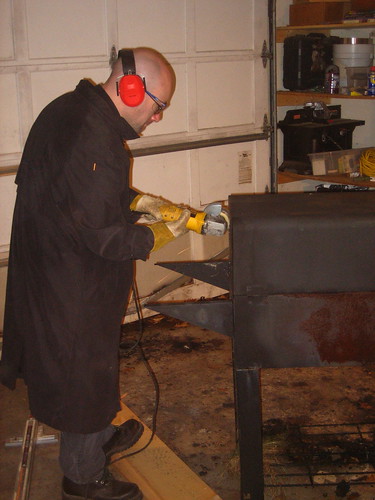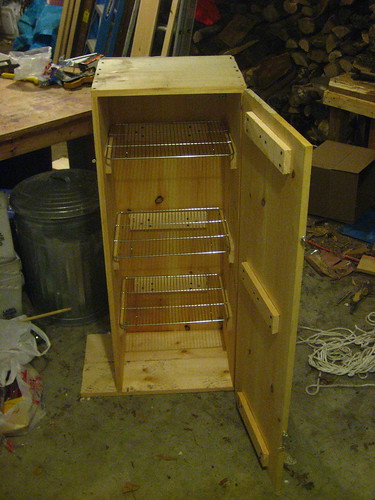I spent my birthday making bacon. There are far worse ways to turn 35.
When I say “making bacon”, I’m not talking about the part where you fry it up in a pan – that happens tomorrow. No, I’ve been engaged in the week-long process to turn pork bellies into bacon, a project that’s involved three of my favorite passtimes: research, carpentry and cooking.
The research part is easy. Ever since Michael Ruhlman and Brian Polcyn’s brilliant “Charcuterie” was published, food hackers have passing around recipes for making your own bacon – I received roughly ten emails after a blogger posted his results with the Ruhlman/Polcyn recipe, and have been meaning to try it myself ever since.
Making bacon’s pretty simple – take some pork belly. Rub it with salt and sugar. (I used maple syrup, “pink salt” – which contains nitrates, useful for killing mold and bacteria, and kosher salt, which, if you think of it, is a bit ironic.) Put it in a plastic bag and let it cure for about five days, turning it each day. Wash off the cure, and let it sit in a cool place overnight to form the “pellicle”, a sticky layer that absorbs smoke. Then smoke it.
It’s this last step that invites you to get creative. You can use a traditional barbecue grill, build a low fire and put the meat as far as possible from the heat. That will serve as a hot smoker and will usually maintain an internal temperature of 200-250F, allowing you to cook the meat using smoke. I wanted to try something slightly different and build a “cold smoker”, a device designed to keep the meet relatively cool (sub-125F) and simply infuse it with smoke. The real reason for the cold smoker is to be able to smoke items like mozarella cheese, which will melt under high heat… but I decided to use the smoker to make very smoky bacon, finishing it in the oven at 200F to make sure it’s properly cooked.
There are good recipes out there for building smokers from trash cans – I ignored them and decided to try something a bit more dramatic. I had an old barbecue grill kicking around, and with help from my friend Bob, chopped off a few pieces and riveted on a few others to create a fairly airtight metal box, with a pair of bottom vents and one large top vent to let the smoke escape.
While Bob smoothed out the rough edges of the firebox, I cobbled together a smoke chamber from a couple of pieces of lumber, some baker’s racks, a pair of hinges and some hook-and-eyes. We mounted the wooden box on the side of the smoker, fashioned a smoke tube from lightweight aluminum, cut a hole in the back of the wooden box and connected the two. To maintain the fire, you open the smoke chamber, retract the tube into it, then open the firebox – an ugly hack, but one that required minimal engineering. Another janky hack is the bucket of rocks, pictured below, which counterbalances the weight of the firebox. This particular hack led to a discussion of a name for our workshop – “Bucket of Rocks Labs”, which may beat out “New Janky Workshop” as a future brand name for these projects.

We call our creation “The Baconator”.
We fired up the smoker at our New Years’ party to smoke some ribs, an early “test piece” of bacon, some fresh mozzarella and about three meters of homemade venison sausage. It worked so much better than anticipated that it’s hard to even describe. The resulting products were delicious, and the apparatus required a minimum of maintenance – it took a long time to get a fire going in the first place, as there’s little air coming into the firebox, but once it caught, it needed tending only once every three hours or so. After smoking today’s batch of bacon, I plan to disassemble and reinforce the smoke box – the difference in humidity between the inside and outside of the smoke chamber is quite severe as ambient humidity in the winter here is about 0%, and hence, the front door of the smoker is already buckling.
As I spend the day smoking bacon and using the last of the raw milk we bought to make a cheddar, I’m realizing how much of the time I spend with friends over New Year’s is spent executing complex projects. Historically, these have been building projects – a trebuchet, a massage table, several iterations of gers, an absurdly unsuccessful hot tub. Lately, they seem to focus on food. Because, hey, just how many failed hot tubs does one man need anyway?
Last year’s focus was on cheese – we turned 25 gallons of organic milk into lovely mozzarella, ricotta, a remarkably good parmesean, and possibly the best cheddar I’ve ever eaten. It’s time consuming, but not difficult, and the results are literally astounding – on our first try, we made cheese that rivalled the stuff I can buy at local gourmet shops. This year, Nathan brought the equipment necessary to create dark chocolate from fermented cacao beans – a powerful juicer to extract the chocolate liquor from the beans, and a melangeur, which mixes the liquor with sugar. On his first try, he and friends produced chocolate better than anything I’ve ever tasted before.
Whether or not making bacon, cheese, chocolate or sausage is something you’d want to base a party around is up to you, but I’ve come to the conclusion that it’s pretty central to how my group of friends gets together. Almost all of us have highly cerebral day jobs and rarely get to pull out the power tools. And while we all enjoy talking to each other about serious things – what you’re working on, thinking about, aspiring towards – it’s wonderful to have a collective joint project to allow you to spend time together without deep conversation. Working together creates a bond, a form of social capital that helps keep us together from year to year.
In other words, we make bacon together because we’re friends… and we’re friends because we make bacon together.
There’s a longer, deeper post about the power of the collective joint project, looking at how projects like Global Voices manage to bring people together across national, cultural and linguistic lines. And while it’s worth thinking about, it’s going to have to wait for another time. I’ve got bacon to fry.



Looks yummy!
I have about 30lbs of ground venison in my freezer. Care to share your venison sausage experience?
David, venison makes a very, very lean sausage. You’ve got to counterbalance it with something else, otherwise your sausage will be inedible. I used the rind of some other bacon, as well as boston butt (a shoulder cut of pork) to add some more fat to it, in a roughly 2 parts venison, one part pork ratio. I might have used more pork had I not had lots of venison in the fridge. I did one batch seasoned with apple, fennel and black pepper, another with red pepper flakes, some rind of aged gouda cheese (happened to be hanging around), oregano and black pepper. Put both into medium hog casing, boiled for about ten minutes, then seasoned in the cold smoker for about 2 hours. Cut each link in half, sauteed lightly in olive oil (this is very lean sausage) and served with mustard. Very good stuff.
Hmm…New Braunfels charcoal grill? Looks familiar – I’ve got the same model . Great grill for parties, as it’s freakin’ huge. Did you come up with a solution for the problem with the screws needing tightening each month?
Nice bacon!
Venison rib”s can be cooked many diferent ways first you must clean all the tallow off them. Marinate them over night then puy them on the smoker. Or you can roast them in the oven, make up some dressing (stouphing) and place a layer between several racks of rib”s place the rest right on top of them and let it cook.
Comments are closed.